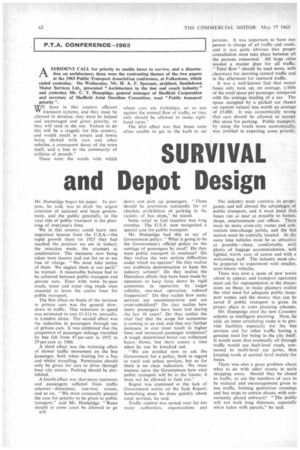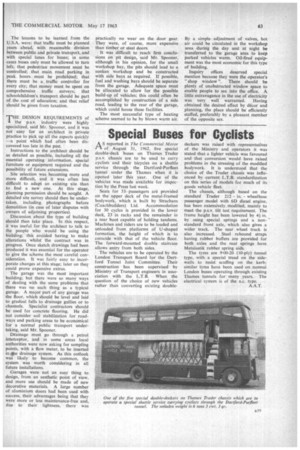SURVIVAL and Depot Design
Page 64

Page 65

If you've noticed an error in this article please click here to report it so we can fix it.
Mr. Humpidge began his paper. Its purpose, he said, was to draw the urgent attention of national and local government, and the public generally, to the vital role of public transport in the planning of everyone's lives.
We in this country could learn very important lessons from the U.S.A.—the rapid growth there (in 1925 they had reached the position we are in today.); the mistakes made, the attempts at amelioration. The measures now being taken were lessons laid out for us to sec free of charge. "We must take notice of them. We neglect them at our peril;" he warned. A reasonable balance had to be achieved between public transport and private cars. Even with town by-pass roads, inner and outer ring roads were essential to leave the centre freer for public transport.
The first effect on buses of the increase in private cars was the general slowdown in traffic. This reduction in speed was estimated to cost £1-£11 in. annually, in London alone. The second effect was the reduction in passengers through use of private cars. It was estimated that the proportion of passenger mileage travelled by bus fell from 47 per cent in 1952 to 29 percent in 1960.
A third effect was the irritating effect of slower traffic movement on the bus trassenger, both when waiting for a bus and whilst travelling. Permission should only be given for cars to drive through busy city streets. Parking should be prohibited.
A fourth effect was that many operators and passengers . suffered from traffic schcmes—diversions, one-way streets, and so on, "We must constantly present the case for priority to be given to public transport," said Mr. Humpidge. "Buses should in some cases be allowed to go
1138
down and pick up passengers. "There should be provisions nationally for an absolute proh:bition of parking in the vicinity of bus stops." he stated_ Some relief in fuel taxation was long overdue. The U.S.A. now recognized a special case for public transport.
Mr. Humpidge had this to say of Government policy: " What is going to be the Government's official policy on the carriage of passengers by road? Do they want public transport to continue? Do they realize the very serious difficulties under which we operate? Do they realize our stubborn determination to keep the industry solvent? Do they realize the Herculean efforts that have been made by operators to keep fares down by rigid economies in operation, by larger vehicles, one-man operation, reduced frequencies? Do they realize how many services are unremunerative and are cross-subsidized? Do they realize how many passengers have been lost during the last 10 years? Do they realize the vital fact that the scope for economies is coming to an end, and that any further increases in cost must result in higher Fares and increased passenger resistance? A tough, determined boxer can withstand heavy blows, but there comes a time when he can be knocked out.
"We are entitled now to ask the Government for a policy, both in regard to rural and urban services, but so far there is no clear indication. We must impress upon the Government how vital public transport will be in the future; it must not be allowed to fade (RIC Regret was expressed at the lack of Government action on the Jack Report. Something must be done quickly about rural services, he said.
Traffic control was spread over far too many niithorities, organizations and The industry rntist continue its propaganda and tell abroad the advantages of public transport, and it must insist that. buses run as near as possible lo homes, shops, entertainment and offices. There must be more cross-city routes and convenient interchange points, and the bus station must be centrally located. At the same time vehicles must be as attractive as possible—clean, comfortable, with plenty of luggage accommodation, well lighted, warm, easy of access and with a welcoming staff. The industry must be prepared to experiment with smaller, semi-luxury vehicles.
There was now a spate of new towns about to appear, and transport operators must ask for representation in the discussions on these; to make planners realize the vital need for adequate public transport routes, and the money that can be saved if public transport is given its proper place in town planning schemes.
Mr. Humpidge cited the new Coventry scheme as intelligent planning. Here, he said, an inner circulating route is to provide facilities especially for the bus services and for other traffic having a genuine need for being in the city itself. It would seem that eventually all through traffic would use high-level roads, connected to multi-level car parks, thus keeping roads at normal level mainly for buses.
There was also a great problem about what to do with older streets in main shopping areas. Should they be closed to traffic, or are the numbers of cars to be reduced and encouragement given to bus traffic, limiting pedestrian crossings and bus stops to certain places, with conveniently placed subways? "The public will not walk long distances, especially when laden with parcels," he said.
The lessons to be learned from the U.S.A. were: that traffic must be planned years ahead, with reasonable division between public and private transport, and with special lanes for buses; in some cases buses only must be allowed to turn left; that pedestrian movement must be controlled; that main road parking in peak hours must be prohibited; that there must be a traffic controller for every city; that money must be spent on comprehensive traffic surveys; that schoolchildren's transport should be part of the cost of education; and that relief should be given from taxation.
THE DESIGN REQUIREMENTS of I the p.s.v. industry were highly specialized, said Mr. Spooner, and it was not easy for an architect in private practice to pick up all the aspects quickly —a point which had often been discovered too late in the past.
Instructions to the architect should be as detailed as possible, including all the essential operating information, special furniture or equipment required and the possibility of future extensions.
Site selection was becoming more and more difficult, and it was often less difficult to adapt an existing site than to find a new one. At this stage, planning permission should be sought. A detailed site survey should then be undertaken, including photographs before demolition (in case of later disputes with owners of adjoining properties).
Discussion about the type of building should then take place. In this respect, it was useful for the architect to talk to the people who would be using the building; this avoided having to make alterations whilst the contract was in progress. Once sketch drawings had been produced it was essential for the operator to give the scheme the most careful consideration. It was fairly easy to incorporate changes at this stage; later on they could prove expensive extras.
The garage was the most important building; but there were so many ways of dealing with the same problems that there was no such thing as a typical garage. A major part of any garage was the floor, which should be level and laid to gradual falls to drainage gullies or to channels. Specialist contractors should be used for concrete flooring. He did not consider soil stabilization for roadways and parking areas to be economical for a normal public transport undertaking, said Mr. Spooner.
Drainage must go through a petrol interceptor, and in some areas local authorities were now asking for sampling points, with a flow meter, to be inserted in .se drainage system. As this outlook was likely to become common, the system was worth considering in all future installations.
Garages were not an easy thing to design, from an aesthetic point of view.
and more use should be made of new decorative materials. A large number of aluminium doors had been used with success, their advantages being that they were more or less maintenance-free and, due to their lightness, there was practically no wear on the door gear. They were, of course, more expensive than timber or steel doors.
It was difficult to reach firm conclusions on pit design, said Mr. Spooner, although in his opinion, for the small workshop bay, the pits should lead to a sunken workshop and be constructed with side bays as required. If possible, fuel and washing bays should be separate from the garage. Adequate space must be allocated to allow for the possible build-up of vehicles; this could often be accomplished by construction of a side road, leading to the rear of the garage, which could house these facilities.
The most successful type of heating scheme seemed to be by blown warm air. By a simple adjustment of valves, hot air could be circulated in the workshop area during the day and at night be transferred to the garage area to keep parked vehicles warm. Oil-fired equipment was the most economic for this type of building.
Inquiry offices deserved special mention because they were the operator's "shop window ". There should be plenty of unobstructed window space to enable people to see into the office. A little extravagance in the use of electricity was very well warranted. Having obtained the desired effect by d6cor and planning, the place should be efficiently staffed, preferably by a pleasant member of the opposite sex.












































































































